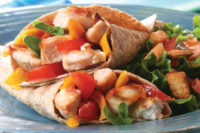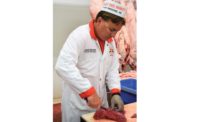Consumer options for animal proteins stretch beyond the typical red and white meat. Seafood, whether it be fish, crustaceans or mollusks, have a wide audience as well. While the seafood industry has its challenges that are unique to the animal protein industry – shelf life being a notable example – consumer trends tend to overlap across all types of proteins. The same demands that are affecting the pork, beef or chicken sectors have an impact for seafood as well.
As an example, the need for convenience has spurred growth in meat snacks, which has seen amazing growth not only in sales but also in brand names. Until recently, consumers haven’t had a chance to equate “seafood” and “convenience,” but that is changing. Earlier this year, SeaPak Shrimp & Seafood Co. introduced an On-the-Go Shrimp Cocktail package that is a frozen, thaw-and-go product.
Leslie Harris Thomas, marketing manager for SeaPak, says that the seafood category has seen a rising demand for quick-and-easy, shareable, snackable solutions.
“This shift has been most noticeable among young families, with millennial moms and dads seeking out seafood more often – they’ve been prioritizing value, quality and taste, while also looking for more variety,” she says. “When it comes to protein snacks, we’re providing a seafood solution with our SeaPak On-the-Go Shrimp Cocktail, which is the first of its kind in the seafood industry.”
SeaPak has been a leader in the shrimp category, including jumbo butterfly shrimp, shrimp scampi, and popcorn shrimp. The company also expanded its SeaPak Selections line of lighter, healthier choices with the addition of two frozen soups: Shrimp Wonton Soup and Thai Coconut Shrimp Soup.
Thomas says that frozen food sales have been on the rise, and consumer demand for seafood options, particularly new options in seafood, is rising as well.
“Thanks to growing awareness for international tastes and flavors, today’s seafood shopper has become more adventurous in their seafood selections. We’re also noticing a stronger consumer preference for brands that have an authentic sourcing and sustainability story to tell, and we certainly have one of those stories,” she adds.
Sustainability is a part of the seafood industry, like it is with meat and poultry. A company’s sustainable initiatives are a big part of its story, and consumers want to know about them. Earlier this year, SeaPak announced its partnership with the Global Sustainable Seafood Initiative (GSSI).
“GSSI’s unique approach to assessing seafood certification – for both aquaculture and wild-caught – aligns with the brand’s history of driving progress in sustainable seafood,” Thomas explains. “We are firm believers in upholding and surpassing certification requirements, and we require that our procurement partners and suppliers also meet the highest social and environmental standards.”
There are times when the latest and greatest new product is actually a reinvention of a traditional food item. Shuckman’s Fish Co. & Smokery, located in Louisville, Ky., has a long history as a butcher shop and grocery market. In the 1980s, the company noticed that more of its customers were buying fish and other seafood products. Shuckman’s decided to enter into the fish processing business, giving the customers what they wanted.
Shuckman’s offers products like a smoked salmon, rainbow trout or whitefish, all hand-sliced. However, some of its most popular products harken back to its meat processing history. The company offers salmon breakfast sausages, bratwurst and Italian sausages.
“We do it the old-school way. It’s ground, it’s not chopped, and then we stuff it into a hog casing and hand-twist it,” says Lewis Shuckman, president and third-generation of his family to run it. “That’s a market that I think really needed attention. We were in the sausage business, so I just took the recipes from my grandfather and my dad and incorporated those into the salmon.”
The company took a couple of years to fine-tune the salmon sausages, making sure that they’d be a successful product out of the gate. The decision to make it a hand-twisted product with natural casings was made to keep the ends of the sausage closed. If the ends were left open, the protein would leak out of the casing when put on the grill.
“You get an extremely healthy protein, but it’s presented in an old school format,” he says. Shuckman relates the story about finding a prospective customer who hadn’t eaten a bratwurst in five years because of doctor’s orders, but he was able to eat all the Shuckman’s salmon brats that he wanted.
The idea of the salmon burgers came about after looking at the other products that are on the marketplace. He said that most of the products had heavy amounts of salt, pepper, sugar and other spices. The Shuckman’s version has a much simpler ingredients list.
“We talked to our customers who said, ‘We can do that [adding spices]. We can pick up a salt and pepper shaker.’ That launched that product,” he says.
As a small processor, Shuckman’s produces its own sausages, smoked fish, a variety of seafood dips and Kentucky Spoonfish Caviar, a freshwater caviar derived from the paddlefish. Shuckman sees the seafood sector continually expanding to new markets as well. The shelf life issues in seafood can pose problems, but innovative companies will find solutions.
“I just see a steady growth of value-added,” Shuckman says. “You have all these nice meal kits that you can have delivered to your house or be picked up at the grocery. I see the fish and seafood industry getting into it at some point in time. I think within the next two years for sure they’ll get into that game, as soon as they figure out how to do it.”







Report Abusive Comment